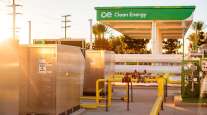Ports Turn to Natural Gas in Quest for Cleaner Marine Fuel

The tightening of emissions limits for deep-water ships has some of North America’s busiest ports chasing a new opportunity.
The UN’s International Maritime Organization last year cut limits on sulfur in marine fuels to 0.5% from 3.5%, starting in 2020. The target: So-called bunker fuel, a cheap, tar-like oil residue used by most ships.
Now ports in Vancouver, Los Angeles and Tacoma are studying whether they can profit from supplying liquefied natural gas, which emits virtually no sulfur, as a cleaner alternative fuel that’s almost as cheap.
While the use of more expensive fuel oil or bolt-on scrubbers can help existing ships slip under the limit, LNG is the fuel of the future for new vessels, according to Norway-based DNV GL, which certifies ships for safety. Exxon Mobil Corp.’s 2016 energy outlook sees use of LNG growing to 10% of marine fuels by 2040 from 1% in 2016.
"It’s something that we want to be at the leading edge of," said Robin Silvester, CEO of Vancouver’s port authority, which is set to issue a study shortly on the potential market. "That will be the next way that marine emissions can be significantly reduced.”
High concentration of sulfur contributes to so-called acid rain, haze and air particulate pollution that can penetrate deep into human lungs and pass into the bloodstream.
About 97 ships worldwide are powered by LNG with an additional 91 on order, according to DNV GL. By 2020, the number may rise to around 250, excluding LNG carriers and inland waterway vessels, DNV reports.
Most LNG-fueled ships now in use travel shorter routes, such as in the Baltics or between Florida and Puerto Rico. In most of these cases, LNG is delivered onto vessels by truck, slowing refueling and limiting its use to smaller vessels.
Heftier infrastructure that ports will need to supply LNG to deep-sea ships is just starting to emerge. In 2014, Rotterdam became the first port where ship-to-ship LNG fueling was allowed. The first onshore fueling station with LNG opened in 2015 at Norway’s Stavanger port, equipped with a loading arm designed for the fuel.
Ships accounted for about 3.1% of all global emissions between 2007 to 2012. With freight volume set to almost quadruple by 2050, marine transport could grow to 17% of CO2 emissions alone, according to reports by the Organization for Economic Cooperation and Development and the European Parliament. A global shipping industry fueled entirely on LNG could emit 20% less CO2, proponents estimate.
There may be other benefits as well. A 2014 Canadian study weighed the cost of investing in LNG propulsion systems for vessels that spend almost all their time in emissions-controlled waters. The result: The expense incurred in fitting a large ship to run on LNG from the outset was repaid in just one year.
With the North Pacific set to surpass the North Atlantic as the world’s busiest trading corridor, the competition among ports to serve traffic to and from Asia is likely to intensify between the United States and Canada, which together account for the fourth-biggest proven natural gas reserves.
Geography and geology could give Canada an edge.
Shipping times to Asia’s biggest hubs from British Columbia are as much as three days faster than from other North American ports, due to the Earth’s curvature. Vancouver already has access to natural gas, with two Fortis Inc. storage facilities for the fuel located nearby.
At the same time, there are more than 20 proposals to build LNG export terminals along the British Columbia coastline in a drive to send LNG to Asia.
The ability of U.S. ports to compete is based on the availability of low-cost gas from shale formations. The United States already has the technology to build refueling stations, with facilities in Jacksonville, Florida, and at Louisiana’s Port Fourchon. Puget Sound Energy Inc.’s $310 million project in Tacoma, Washington, will fuel tankers owned by Tote Inc. when it’s completed in late 2019.
This past November, the Pasha Group’s Hawaii unit announced orders for two LNG-fueled containerships for delivery in 2019 and 2020, with the option to buy another two. Those vessels may be fueled out of Southern California, serving as “a catalyst for future infrastructure that would be required by worldwide carriers,” said Matt Jackson, vice president of LNG business development at Crowley Maritime Corp.
“Shipping lines have become more interested in LNG fuel,” Chris Cannon, director of environmental management at the Port of Los Angeles, said in an e-mail. “We’re studying how this can be done in an efficient and environmentally safe manner.”
Even with the new sulfur limits, the changeover to LNG likely will be slow, dependent on the construction of new ships rather than making over existing ones. Persuading companies and ports to actually invest in such a big change is challenging, said Madeline Jowdy, senior director of global gas and LNG at Pira Energy Group in New York.
"The problem will remain a chicken-and-egg dilemma for quite some time," Jowdy said.




